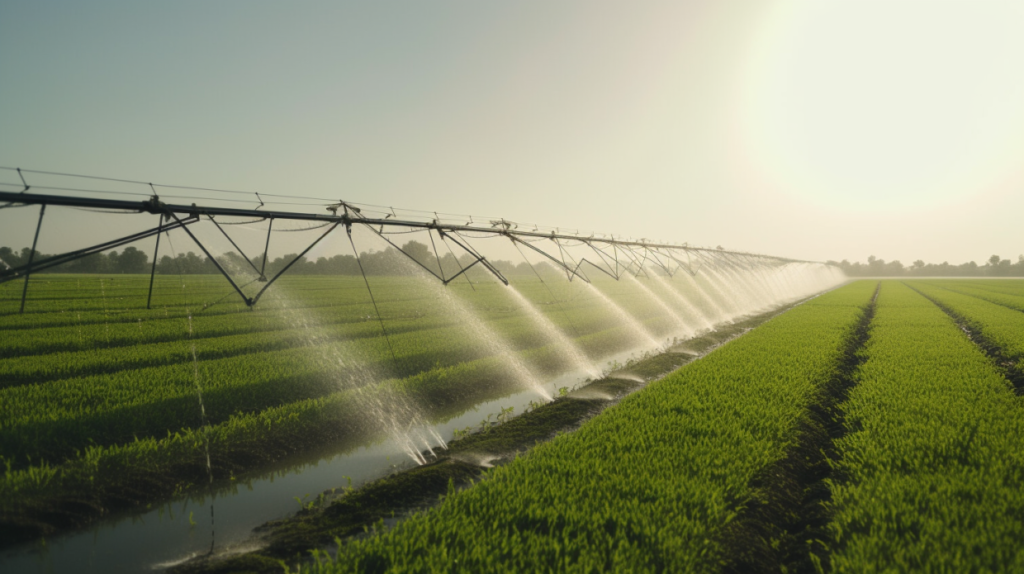Irrigation is important for maintaining beautiful and healthy landscapes. Different landscapes require different irrigation systems. Choosing the proper irrigation method can impact plant health, water usage, and maintenance costs. Below are the types of irrigation systems used:
1. Surface irrigation
Surface irrigation is the oldest method of irrigation. This method relies purely on gravity to distribute water across the soil. Water is directly applied to the field, and it flows naturally.
Benefits of Surface Irrigation:
- The cost to install and operate is very low.
- It is easy to maintain as it does not require much technical knowledge.
- Does not require any mechanical equipment
- This method is the best option for large, flat agricultural fields.
Besides its benefits, Surface irrigation can lead to some significant issues like water wastage due to evaporation, uneven water distribution resulting in poor crop growth, soil erosion can be caused due to weed growth and also this system is not suitable for all soil types.

2. Drip Irrigation
Drip irrigation is efficient as it delivers the water directly to the plant roots through a network of tubes, which ensures maximum efficiency.
Benefits of Drip Irrigation:
- Helps save water by reducing evaporation
- Ensures plant health, as there is consistent moisture on the roots
- Keeps the surrounding areas dry, which helps reduce weed growth
- This is the best option for irregular terrains and areas with low water supply
This system can be efficient, but the initial installation cost is very high, it requires regular maintenance, and the emitters can get dirty easily, affecting the flow of water. If this system is improperly installed or designed, it can lead to uneven water distribution, eventually leading to plant loss.

3. Sprinkler Irrigation
Sprinkler systems help distribute water evenly, the same effect as a rainfall. They are primarily used in residential gardens, golf courses and agricultural areas.
Benefits of sprinkler irrigation:
- Helps spread the water evenly to large areas, which helps cover these areas quickly.
- Can be used in uneven landscapes and various types of terrains
- Excessive labour and time consumption can be saved as it is automated.
Sprinkler systems can be very efficient for crops, but can involve certain demerits as they involve high installation and regular maintenance costs. Additionally, uneven water distribution can happen if the system is not properly managed or designed.

4. Subsurface Irrigation
This method directly pours water into the plant roots through a tube or pipe, making it one of the most water-efficient methods.
Benefits of subsurface irrigation:
- Helps to eliminate the surface evaporation
- Minimizes weed growth as the surface soil is dry
- The landscapes look clean and neat as the pipes will be hidden.
Subsurface irrigation is effective, but it comes with several disadvantages. Specialized equipment and a professional setup are required for installation, which makes this method expensive. Maintaining this system is also difficult, as detecting leaks or breakages underground regularly is not feasible. As this is installed underground, plant roots can disturb the irrigation lines causing damage or blockages.

5. Centre Pivot Irrigation
This method is mostly used in large-scale farming. It mainly consists of a rotating sprinkler that helps to cover a circular area.
Benefits of Centre Pivot Irrigation:
- This is the best method for irrigating larger areas with minimum labor.
- Water is distributed evenly across the area in a circular motion
Centre pivot irrigation involves major installation costs, which will not be affordable for small-scale farmers. This system cannot be used on irregularly shaped areas because the water will not spread across the non-circular areas. It consumes a huge amount of energy to pump water to large areas.

6. Lateral Move Irrigation
This system helps move and distribute water across a rectangular field. Even though this method provides uniform water coverage, it requires a levelled field for optimal efficiency.
Benefits of Lateral Move Irrigation:
- Uniform water application across rectangular plots
- As the system is automated, it helps reduce labor costs.
- Efficient usage of water for medium to large firms.
Even though lateral move irrigation is the best option for uniform application, it is expensive and requires flat surfaces to be installed. Maintenance can be difficult, and any malfunctions can result to crop failures in large sections of the area.

7. Manual Irrigation
Manual irrigation is the most labour – intensive method, as water is applied through hoses, buckets or watering cans.
Benefits of Manual Irrigation:
- Equipment investment is not required as this method only requires manpower
- This is the most ideal method for small gardens and indoor plants
- Water quantity can be controlled as the water is poured manually
- This system can be implemented in areas where advanced systems have limited access
Even though this is a very simple method, it does cause some concerns. This system demands huge labour and is time-consuming, which is not a good option for large-scale farming. Water distribution is uneven, which may lead to overwatering or underwatering of plants. This method mainly depends on human availability, which can result in irregular watering schedules.

FAQs
- Which irrigation system is the least expensive option?
Surface irrigation is very cost-effective to install and operate, specifically for large fields.
- Which irrigation method is optimal for irregular terrains?
Drip irrigation is the best method for irregular terrains as the network of tubes are laid out evenly to distribute water directly to the plant roots.
- Which irrigation method is suitable for home gardens or small areas?
Manual irrigation is the best option for small gardens and indoor plants as it requires very minimal water.
- Are sprinkler systems effective for all plants?
No, it’s not; some crops are sensitive to leaf wetness, and they may suffer from fungal diseases.
- Which irrigation system is best for large-scale farming?
Centre Pivot and Lateral move systems are the most effective systems for large-scale areas as they can cover large areas with minimum labor usage.



